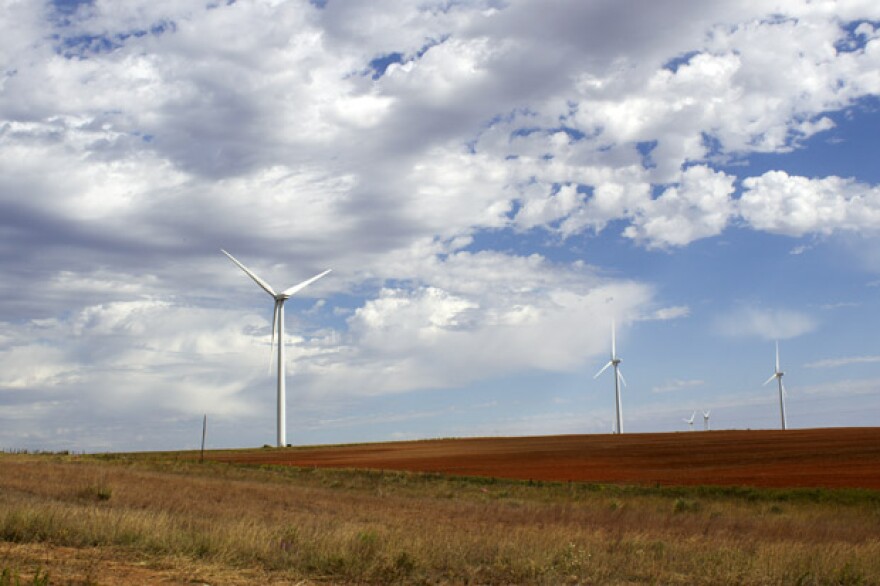The 2015 session is still months away, but the newly elected Oklahoma Legislature has already started talking about how to divvy up roughly $7 billion in state appropriations.
Some prominent lawmakers are promising to re-examine tax credits and economic incentives worth hundreds of millions of dollars. Some of those incentives are used for wind energy, which the industry says are working.
Big Wind
Oklahoma is in the middle of a wind boom. In the last five years, installed wind power capacity has soared more than 200 percent. Last year, Oklahoma was the country’s fourth-largest producer of wind-powered electricity, data from the U.S. Energy Information Agency show. But every energy boom comes with a cost.
“Our state is the wild, wild west of wind development,” Penny Gann-Bradford, representing the Osage Nation, said at a Dec. 3 hearing on wind energy at the Oklahoma Corporation Commission, which was tasked by Senate President Pro Tempore Brian Bingman, R-Sapulpa, to examine the creation and implementation of stricter wind energy rules and regulations.
“Wind developers are drawn to states and areas with little to no regulation, such as Oklahoma,” Gann-Bradford said at the hearing. “The lack of regulation is no cause for pride.”
Oklahoma’s wind boom has encountered opposition from landowners who don’t want a wind farm next door, as well as tribes and conservationists who say turbines, if left unchecked, could kill threatened bird species and spoil sensitive grasslands. Conversely, wind developers have lauded the economic potential of Oklahoma’s wind, and other landowners are welcoming turbines and the monthly checks the companies issue for wind farm acreage.
Beyond the environmental and safety worries, opponents also point to tax credits and incentives as an indication that the promise of wind power is overstated, and to question whether wind energy can survive without taxpayer subsidization.
“The Osage Nation suggests that every step of wind permitting be transparent, including the honest disclosure of the degree to which taxpayers are paying for industrial wind development,” Gann-Bradford said.

Incentives, Exemptions, and Credits
The cost of such incentives has skyrocketed. Income tax credits and property tax exemptions have swelled from $7 million in 2010 to $50 million this year. That total could reach $67 million by 2018, according to projections from a State Senate Finance Committee.
But the wind industry says Oklahoma has received a $6.1 billion dollar return on its $120 million investment, and developers say the incentives are working as intended.
“Incentives … can make a wind power project more profitable and, ultimately, spur economic development to allow facilities that might not have existed,” says Stephen Pike, vice president of operations and maintenance for Enel Green Power North America.
Enel owns a handful of wind farms in Oklahoma. Four of those projects, including two already in operation — the 150-megawatt Rocky Ridge wind farm near Hobart and the 235-megawatt Chisholm View wind farm near Enid — and two in development – the 150-megawatt Origin project in Murray and Carter Counties and the 200-megawatt Goodwell project in Texas County — likely wouldn’t have been destined for Oklahoma if it weren’t for the tax incentives.
In Oklahoma, Enel often buys established wind farm projects from other developers, but Pike says tax incentives play a considerable role in the site-selection process.
Legislation and Regulation
Lawmakers have promised stricter wind energy legislation next year. State Rep. Earl Sears, R-Bartlesville, says a bill addressing wind energy siting, notification and decommissioning is imminent. Other lawmakers, including David Dank, R-Oklahoma City, have suggested similar efforts with wind industry tax credits.
Gov. Mary Fallin says an investigation into the merits of booming tax breaks for businesses in Oklahoma is needed, but she supports incentives for the wind industry.
“They have worked. If you looked at where we’ve been to where we are today and the billions in investment that we’ve seen,” Fallin told StateImpact in an interview at the annual energy conference in September 2014. She was happy when wind companies told her Oklahoma had beaten Texas, Kansas and Nebraska for new wind farms.
“They’re getting ready to spend huge sums of money in the State of Oklahoma, which helps the landowners, it certainly helps our power companies,” Fallin said. “It’s a clean form of energy, it’s a renewable form of energy. And it’s an important part of our mix.”
Wind Economics
The future of wind energy comes down to economics. For wind power to succeed, it can’t be more expensive than the competition — namely coal and natural gas. Nationally, that’s starting to happen in many markets — even without taxpayer subsidies.
There’s another financial consideration at work: Renewable energy is increasingly attracting business. As the wind industry follows the money, big businesses are chasing wind and other forms of renewable energy.
“Certainly the availability or the access to more sustainable sources of power like renewables is an important factor that we look at when we’re deciding both whether to site a new data center or to expand an existing data center,” said Michael Terrell, senior energy policy council at Google.
In 2011, Google opened a new data center in Pryor. A big part of that deal was a power-purchase agreement with a NextEra’s 100-megawatt Minco II Wind Energy Center.
Renewable energy is a corporate priority for Google and other companies like Walmart, Apple, Costco, Khol’s and Ikea — the kind of big-name employers states and local communities are fighting to attract.
“Our goal is to make it as easy for companies and others who want to buy renewable energy to do that,” Terrell says.
---------------------------------------------
StateImpact Oklahoma is a partnership among Oklahoma’s public radio stations and relies on contributions from readers and listeners to fulfill its mission of public service to Oklahoma and beyond. Donate online.







